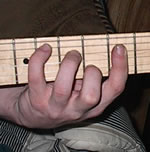The Absolute Basics
These lessons will lay a foundation for the rest of the lessons. Work through one beginner guitar lesson at a time. Try not to skip around, because you might miss something important.
- Parts Of The Guitar
- How To Hold The Guitar
- The Pick And It’s Use
- The History Of Pick
- Naming The Strings
- Tuning Your Guitar
- How to Fret The Guitar
- What Are Dot Inlays?
- Dot Inlays And The 12th Fret
- The 12 Notes On The Guitar
- Primary Notes Chart
- How To Read Tablature
- Fretboard Exercise
Open Chords
Many people find learning guitar chords difficult at first. Spend a little time every day working on fretting them and you’ll begin seeing some progress after a week or so. Here we’re going to concentrate on learning commonly used open chords. It’s worth the effort, because once you learn a few chords you can soon start playing songs.
- How To Read A Chord Diagram
- How To Play Open Chords
- Press Down Exercise For Better Chord Changes
- Zen And The Art Of Chord Changes
Strumming
Once you can play a few chords it’s time to start strumming. Playing in time to the beat is another common obstacle. Take it slowly and follow the exercises below.
- Introduction To Rhythm
- Basic Strumming Exercise
- Strumming Beginner Guitar Lesson One
- Strumming Beginner Guitar Lesson Two
- Strumming Beginner Guitar Lesson Three
- Strumming Beginner Guitar Lesson Four
- Strumming Beginner Guitar Lesson Five
- Strumming Beginner Guitar Lesson Six
- Strumming Beginner Guitar Lesson Seven
More…
Intervals For The Guitar (PDF)
My Guitar Reference Book (Printer-Friendly Charts)
E-Z Electric Guitar Collection
E-Z Acoustic Guitar Collection
Tablature
Music Theory
What’s Next?
It’s up to you! There’s no way to make you practice and that’s the only way you’re going to get any better. You’ll get better with regular practice. If you don’t practice you will find yourself getting nowhere. Here are some tips to help improve your practice time:
- It’s a good idea to practice at least a little every day. Set aside time each day to practice undisturbed for 10 or 15 minutes a day. You will mark improvement from day to day and week to week.
- Set both short and long-term goals. An example of a short-term goal may be to learn your basic chord patterns. An example of a long-term goal may be to learn all the notes on the fretboard.
- If you start to feel too much discomfort in your hands and/or fingers you may want to take a break. Over time the muscles in your hands will develop to the point where they won’t cramp as much, and your fingertips will develop hard calluses.
- Don’t get ahead of yourself. If you come across something that you do not understand don’t skip it. Skipping material is like skipping chapters in a novel.
you’ll be scratching your head in confusion. - Concentrate on your weaknesses. Don’t spend most of your practice time on the areas that you would consider your strengths. Take the time to make your weaknesses strong.
- Try recording a practice session then go back a month or two later and listen to it. You’ll be amazed at the progress you’ve made if you’ve stuck with regular practice.
